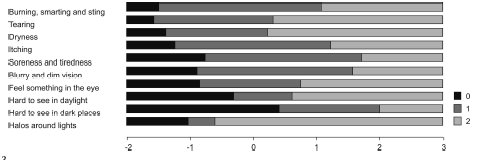Are Standard Instruments Valid for the Assessment of Quality of Life and Symptoms in Glaucoma?
Purpose: To determine if the impact of Visual Impairment Instrument (IVI) and Glaucoma Symptom Scale (GSS) are valid instruments to assess participation in daily living and ophthalmic complaints, respectively, in a glaucoma population.
Methods: Patients with glaucoma were recruited from private and public clinics and completed the IVI and GSS questionnaires. The two scales were assessed for fit to the Rasch model. Unidimensionality, individual item and person fit to the model, response category performance (how respondents differentiate between the response options), differential item functioning (how subgroups, despite equal levels of the underlying trait, respond differently to an individual item), and targeting of items to patients (good spread of items across the full range of patients’ scores) were assessed.

FIGURE 3. Threshold map of the GSS showing ordered thresholds following item rescoring.
Results: One hundred seventy-five participants (mean age = 71 year) were recruited. The majority (65%) had primary open angle glaucoma and good presenting visual acuity ≥6/9 in the better eye (87%). Only one-third of the participants had severe visual field loss in both eyes. Disordered thresholds were evident across all GSS items, indicating that the categories were difficult to discriminate and required category collapsing (5 to 3 categories). There was no evidence of person and item misfit, differential item functioning, and multidimensionality. However, both scales displayed ineffective person-item targeting as a large number of participants demonstrated little difficulty with the most difficult items.
Conclusions: Because of unsatisfactory targeting, The IVI and GSS are suboptimal scales to assess patients with glaucoma but relatively good vision. It is likely that items could be added to optimize the performance of both instruments. There may however be a need to develop a glaucoma-specific instrument to assess Quality of Life in this population.
Key Words: Quality of Life, glaucoma, Rasch analysis, ocular complaints, IVI
Optometry & Vision Science 2007;84:789–796
ECOSSE L. LAMOUREUX, PhD
JOHN G. FERRARO, MHA
JULIE F. PALLANT, PhD
KONRAD PESUDOVS, PhD, FAAO
GWYN REES, PhD, and JILL E. KEEFFE, PhD
Centre for Eye Research Australia, The University of Melbourne, Melbourne, Victoria, Australia (ELL, JGF, GR, JEK)
School of Rural Health, University of Melbourne, Victoria, Australia (JFP),
NH&MRC Centre for Clinical Eye Research-Flinders University and Flinders Medical Centre, Bedford Park South Australia, Australia (KP)
Vision CRC, Sydney, Queensland, Australia (ELL, JEK) and
Royal Victorian Eye and Ear Hospital, Melbourne, Victoria, Australia (JGF)
Accepted for publication 18 January 2007
© 2007 American Academy of Optometry
 Glaucoma QoL
as PDF (1,059 Kb)
Glaucoma QoL
as PDF (1,059 Kb)
![]()
Index of Papers
[ Welcome ][ Publications ]

